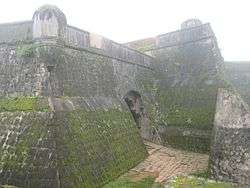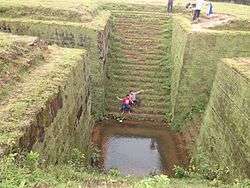Manjarabad Fort
| Manjarabad fort | |
|---|---|
| Sakleshpura, Karnataka, India | |
|
Entrance view of the Manjarabad fort | |
|
A deep well within the Manjarabad fort | |
 Manjarabad fort | |
| Coordinates | 12°54′36″N 75°45′18″E / 12.91°N 75.755°E |
| Type | Fort |
| Height | 19.26 |
| Site information | |
| Owner | Tippu Sultan |
| Open to the public | Yes |
| Condition | Partially restored |
| Site history | |
| Built | 1792 |
| In use | 18th century |
| Battles/wars | Many |
Manjarabad fort is a star fort built in 1792 by Tipu Sultan the then ruler of Mysore [1] on the pattern of the military forts developed by the French architect Sébastien Le Prestre de Vauban. It is in the Hassan district in the Indian state of Karnataka.[2]
Location
The fort is located 10 kilometres (6.2 mi) away from the Sakaleshpura town to its south west, which is on the right bank of the Hemavati River, 23 miles (37 km) from Hassan on the National Highway no 48 that runs from Bangalore to Mangalore. Sakaleshpura is the headquarters of Manjiraba taluk and is a municipality.[3][4][2]
Since the fort is located on a hill at an elevation of 988 metres (3,241 ft), it gives a clear and commanding view of the surroundings. On a clear day, even the Arabian Sea can also be seen from the fort.[5][2]
History
Tipu Sultan built the fort in 1792 at a time when he was establishing his sovereignty over Mysore, fighting against the British East India Company.[2] At this time even the Marathas and the Nizam of Hyderabad had aligned with the British. The Sultan wanted to make the highway between Mangalore and Coorg secure for his expansion programmes. Because he was allied with the French at that time in fighting against the British, he sought the help of French engineers to build a unique fort, unlike any others built in the country. He adopted the design of the military architecture developed by Sébastien Le Prestre de Vauban (1633–1707), France’s well known military engineer and commissioner of fortifications under the French king Louis XIV who had perfected the design of a star-shaped fort.[2]
The fort, when built, was inspected by Tippu Sultan who then found it enveloped in fog and hence named it as Manjarabad fort; the name Manjara is a corrupted version of 'manju' meaning "fog or mist" in Kannada.[6][5]
According to history a tunnel links the fort with the Srirangapatna fort.[4]
Features
The fort, as built and existing, is unlike other forts in Karnataka as it has an octagonal layout with eight walls. The external walls of the fort have been built with granite stones and lime mortar while the interior buildings, which accommodate army barracks, armoury, stores and others, have been built with fired bricks. Apart from these, two cellars were built next to a deep well which were underground structures used to store gunpowder, and these rooms remained cool even during summer months.[5] The fort has sloping walls. It is fortified with bastions which project out from the walls and which are in the form of arrow-heads, unlike the semi-circular or square shaped bastions common in other parts of the country. This gives the fort a star shaped appearance. It is said that the fort is "the most complete Vaubanesque star-shaped fort in India". The projecting bastions, which reduced the "dead zones", gave the soldiers the advantage of firing at any one who came close to the walls of the fort.[2]
Tourism is not well developed in the area. The Tourism Department of Karnataka, pressed by demands from local people of Sakalehspura, have plans to create basic amenities around the fort and also develop a park.[7]
References
- ↑ Ltd 2016, p. 391.
- 1 2 3 4 5 6 Iyer, Meera (4 June 2013). "A star attraction, this fort". Deccan Herald. Retrieved 12 May 2016.
- ↑ Rice 1876, pp. 333–34.
- 1 2 Moro 2015, p. 7.
- 1 2 3 DeSouza 2013, p. 40.
- ↑ Imprint, p. 57.
- ↑ "Sakleshpur historical sites fail to attract tourists". The Hindu. 27 August 2014. Retrieved 12 May 2016.
Bibliography
- DeSouza, Frank S. (November 2013). The Anonymous Birthright. Author House. ISBN 978-1-4918-8469-0.
- Imprint, Amanda. Academic GK Matter-6. Laxmi Publications. ISBN 978-93-80644-70-7.
- Rice, Benjamin Lewis (1876). Mysore and Coorg: Mysore, by districts. Mysore Government Press.
External links
| Wikimedia Commons has media related to Manjarabad Fort. |

